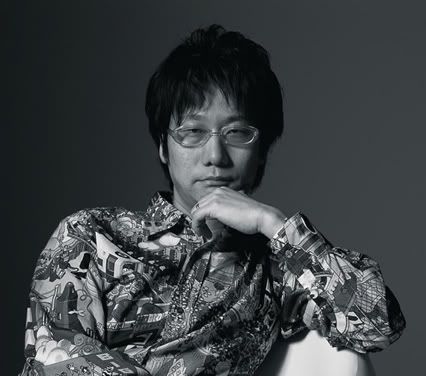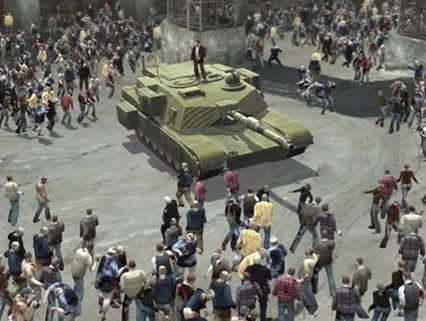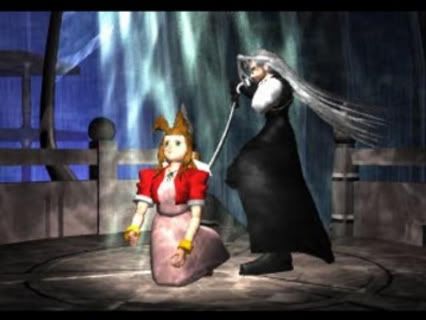Cut The Scenes
 Complaining about cutscenes feels like a futile pursuit for a couple of reasons. Partly because it feels oddly similar to banging a bit of bamboo against the stiff rigor mortis flesh of a deceased equine; partly because it must surely be a fruitless endeavour at this stage. Cutscenes are clearly here to stay and developers are making no secrets about the fact that they all get big, polygonal stiffies whenever they get the chance to live out their moviemaking dreams. I should point out that I have nothing (well…) against cutscenes in theory. In theory they are there to provide the narrative skeleton to a game, presenting aspects of the plot that would have been difficult to convey through gameplay alone. In the olden days they were also a handy tool for developers to show us graphics which the hardware would not have been able to muster up in real time, which broke the flow but looked awesome for the time.
Complaining about cutscenes feels like a futile pursuit for a couple of reasons. Partly because it feels oddly similar to banging a bit of bamboo against the stiff rigor mortis flesh of a deceased equine; partly because it must surely be a fruitless endeavour at this stage. Cutscenes are clearly here to stay and developers are making no secrets about the fact that they all get big, polygonal stiffies whenever they get the chance to live out their moviemaking dreams. I should point out that I have nothing (well…) against cutscenes in theory. In theory they are there to provide the narrative skeleton to a game, presenting aspects of the plot that would have been difficult to convey through gameplay alone. In the olden days they were also a handy tool for developers to show us graphics which the hardware would not have been able to muster up in real time, which broke the flow but looked awesome for the time.
No, my beef with cutscenes is not that they are being used to further a game’s story, but that far too often they are directly working against the actual gameplay. What I mean by that is that certain cutscenes will show us things in the non-interactive parts which contradict what we get to see in the interactive parts. One good example of this can be found in Dead Rising. At one point in the game you are forced to fight a character on foot while she tries to run you over with a motorcycle. When you pull your gun out and begin pumping her full of bullets her body will swallow them up like her skin was made of mimetic poly-alloy, with only minor alterations to her energy bar. Eventually you’ll win and because she’s invaluable to the story she will survive, merely limping away somewhat agitated at your violent advances. In a later cutscene you will find her severely injured – from one gunshot wound. Not any of the dozens you supplied her with, mind you. Either your gun was entirely loaded with peas or the game just pull the rug out and broke its own rules. There is a direct and apparent disconnect between what you do in the game and what the game feels is of dramatic importance, which makes your actions seem irrelevant.

And this game was so realistic until now!
There are several examples of this sort of thing, but there is no greater culprit than the Final Fantasy series. There are simply too many instances in these games where characters find themselves in situations they could easily escape from by using techniques they have shown prowess with in battles, but during the story they never think of utilising them. The most famous moment is surely [Final Fantasy VII spoiler alert] the death of Aeris where a Life spell or a measly Phoenix Down would have helped matters hugely. The same game also features a character forever frozen as a stone statue which the other characters ceremoniously mourn – not for one second considering the usage of a Soft item which up until that moment has worked wonders curing other petrified characters. FF8 sees a moment where Laguna never thinks to use a Cure spell on two of his dying comrades, instead opting to use a combination of tickling and rope-less bungee jump to battle their symptoms.

This could have been avoided, people.
Moments like these are so prevalent that we could all make our own lists (and please do in the comments) but they are not just annoying in a fridge logic sort of way. When the game breaks its own rules for narrative purposes it hurts both the gameplay and the story. The gameplay becomes seemingly moot and your actions seem to have little to no influence on the characters, which in turn makes you feel much less involved in the story. Doing this in RPGs is particularly dangerous because these games are by definition meant to make you feel closely connected to the character you are controlling and the world they inhabit. When the game then ignores these rules at the developer’s whim, it causes a rift in our suspension of disbelief and that sullies our engagement. Admittedly, a good game can still pick up and bring us back to that state of mind, but a better game would not even need to tamper with the rules to begin with.
Valve are, as ever, the shining beacon of excellence for all the lesser plebs to strive towards. They virtually did away with cutscenes altogether in Half-Life and the game is that much more immersive for it. If the game never breaks up, never allowing you to become reduced to a spectator, you will feel much more linked with the events occurring around you. Compare that to, say, Devil May Cry, which always saves the coolest moves and most bombastic action sequences for the cutscenes. When you are pulled back in control and find that you can never perform actions as mind-blowingly awesome as those the very same character just mastered so effortlessly in the cinematic, you doubtlessly feel cheated and more like a bystander than somebody taking part. It has just become you, pressing buttons.

Just like in the movies!
Not to say that there are no games that utilise non-interactive moments well but they are few and far between. Very rare are the games in which the cinematics feel genuinely indispensible and more often than not they seem to hinder rather than aid your involvement in the story and the characters. If developers insist on keeping with the talkies and the movies, then they need to start utilising them in a way that serves the game rather than obstructs it. A game is at its most immersive if the story and the gameplay are seamlessly intertwined, but in order to accomplish that effect you cannot allow for serious discrepancies between the two by making your cutscenes stick out like sore thumbs from the actual gameplay. I guess it depends on whether you value your own cinematic aspirations or the gaming experience the most, and it makes me wonder how many developers would actually tick the latter.
Related posts:





The point you made about Devil May Cry saving the best for the cutscenes is probably why other games of that ilk have come to rely on QTE’s so much. Developers get to show the over the top moves and pretend it’s part of the gameplay, when quite clearly it’s a cutscene in a cunning disguise, although at least in some cases it doesn’t break the flow of the game so much.
it pissed me off so much in mgs4 when raiden spun a gekko with his fucking heels.
Phoenix downs and life spells revive characters who have been knocked out, not characters who have been killed. Neither one would bring Aeris back to life.
That might very well be true but to me it feels just as contrived as the “anti-magic field” in FF8
In my opinion, the virtually doing away with cutscenes in Half-Life 1 and 2 pretty much raped them of plot and made them bland in all aspects other than gameplay. They can’t be immersive if there is nothing to immerse yourself in. Having to make up the story for yourself as you play due to total lack of information doesn’t count as immersion.
MGS:IV was the opposite extreme for me, with needlessly long and poorly edited scenes detracting from the game totally. I don’t need to listen to a 10 minute conversation about ninjas in feudal Japan when the point of the conversation could be summed up with “Use infra-red to see footprints”.